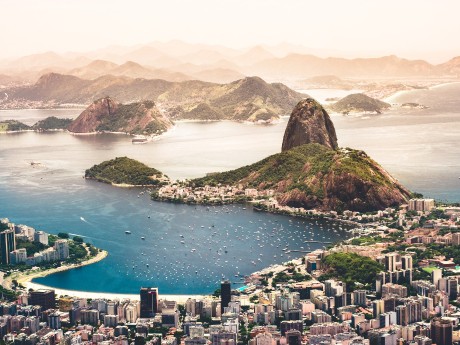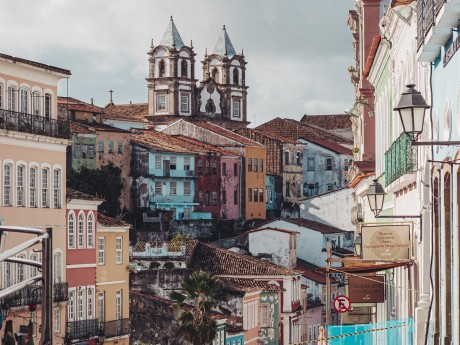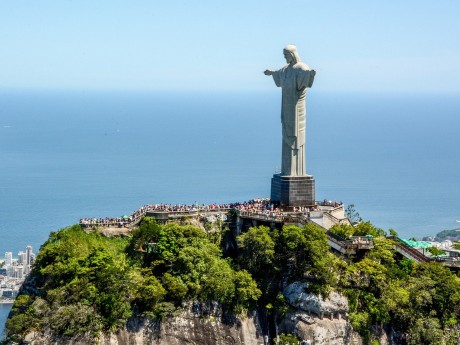Brazil: Rio de Janeiro & Salvador
Escape to the vibrant heart of Brazil with an unforgettable journey to Rio de Janeiro and Salvador. Starting in the vibrant city of Rio de Janeiro, visit the awe-inspiring Christ the Redeemer statue atop Mount Corcovado, offering unparalleled panoramic views. Explore the innovative Museu do Amanhã, seamlessly blending science and innovative design to focus on a sustainable future. Wander through the enchanting Escadaria Selarón, a mesmerizing mosaic-covered staircase renowned for its beauty.
Read more
Escape to the vibrant heart of Brazil with an unforgettable journey to Rio de Janeiro and Salvador. Starting in the vibrant city of Rio de Janeiro, visit the awe-inspiring Christ the Redeemer statue atop Mount Corcovado, offering unparalleled panoramic views. Explore the innovative Museu do Amanhã, seamlessly blending science and innovative design to focus on a sustainable future. Wander through the enchanting Escadaria Selarón, a mesmerizing mosaic-covered staircase renowned for its beauty. Continue your adventure to Salvador, a treasure chest of history and culture. Take a thrilling ride on the Elevador Lacerda, granting you breathtaking views as you traverse between the bustling port and the historic district. Discover the ancient Barra Lighthouse, a testament to Brazil's rich heritage and indulge your senses at the vibrant Mercado Modelo, where you can shop for unique souvenirs while admiring the picturesque bay views. Unwind at Porto da Barra Beach, a haven for water enthusiasts, offering crystal-clear waters perfect for swimming, paddleboarding, and kayaking. Waterviews strives to offer accommodation options within walking distance of water and/or in an area of touristic interest. Our prices include taxes (but excludes local tourist taxes). Customize your trip to your personal preferences with optional activities (hit the “Add Activities’’) or change hotels, etc. Contact us for customization at no extra cost at: Service@waterviewstravel.com
Destinations
- Rio de Janeiro
- Salvador
Itinerary
Rio de Janeiro

Rio de Janeiro is a must see on any trip to Brazil, and is a city that truly offers something for everyone. Visit the towering Christ the Redeemer statue and enjoy views over the city’s picturesque coastline, spend days relaxing on the sands of Copacabana or Ipanema or head to one of Rio's excellent museums, the choice is all yours. By night, the Lapa district comes alive with bustling samba bars and local eateries, and those who want a real taste of Brazil’s vibrant culture can’t miss the city's annual carnival.
Read more
Rio de Janeiro is a must see on any trip to Brazil, and is a city that truly offers something for everyone. Visit the towering Christ the Redeemer statue and enjoy views over the city’s picturesque coastline, spend days relaxing on the sands of Copacabana or Ipanema or head to one of Rio's excellent museums, the choice is all yours. By night, the Lapa district comes alive with bustling samba bars and local eateries, and those who want a real taste of Brazil’s vibrant culture can’t miss the city's annual carnival.
Additional Information
It is a common mistake to think of Rio as Brazil's capital, a distinction it lost on April 21, 1960 when Brasilia became the capital. Beaches such as Copacabana and Ipanema, the Christ The Redeemer (Cristo Redentor) statue, the stadium of Maracanã and Sugarloaf Mountain (Pão de Açúcar) are all well-known sights of what the inhabitants call the "marvelous city" (cidade maravilhosa), and are also among the first images to pop up in travelers´ minds, along with the Carnaval celebration.
The South Zone holds most of Rio's landmarks and world-famous beaches, in an area of only 43.87 km² (17 sq miles). Many of them are within walking distance of each other (for instance, the Sugarloaf lies about 8 km (5 miles) from Copacabana beach). Most hotels and hostels are located in this part of the city, which is compressed between the Tijuca Range (Maciço da Tijuca) and the sea. There are important places in other regions as well, such as Maracanã stadium in the North Zone and the many fascinating buildings in the Centre.
Sadly, most people also know Rio for its violence and crime, especially related to drugs. And social problems, as slums or favelas, areas of poor-quality housing and living; these slums are usually located on the city's many mountain slopes, juxtaposed with middle-class neighbourhoods.
History
Rio was founded in 1565 by the Portuguese as a fortification against French privateers who trafficked wood and goods from Brazil. Piracy played a major role in the city's history, and there are still colonial fortresses to be visited (check below). The Portuguese fought the French for nearly 10 years, both sides having rival native tribes as allies. For the next two centuries it was an unimportant outpost of the Portuguese Empire, until gold, diamonds, and ore were found in Minas Gerais in 1720. Then, as the nearest port, Rio became the port for these minerals and replaced Salvador as the main city in the colony in 1763. When Napoleon invaded Portugal, the Royal Family moved to Brazil and made Rio capital of the Kingdom (so it was the only city outside Europe to be capital of a European country). When Brazil became independent in 1822, it adopted Monarchy as its form of government (with Emperors Pedro I and Pedro II). Many historians and Brazilians from other places say cariocas are nostalgic of the Royal and Imperial times, which is reflected in many place names and shop names. In 2009, the city won their bid to host the games of the XXXI Olympics in the summer of 2016. This was the fifth bid by the city, whose 1936, 1940, 2004, and 2012 bids lost.
Climate
The climate of the city of Rio de Janeiro is semi-humid tropical. According to the amount of rainfall, there are two seasons: a hot and rainy season, which runs from September to April, and a dry season, which runs from June to August. The amount of rainfall per year is approximately 1200 mm (47.2 inches), raining about 90 days per year. The city usually receives about 2080 hours of sunshine a year. In December and January, the heat and humidity are usually constant, reaching up to 40º C (104º F), but even with the rains, this season is the high tourist season. During winter in the southern hemisphere, temperatures in Rio are usually milder, rainfall decreases, and average temperatures are typically 19° C (66° F) to maximums of 25° C (77° F).
© Sourced from Wikivoyage
Salvador

Often considered as the birthplace of Brazilian culture, Salvador is the vibrant, beating heart of Bahia. The city is located in the northeast of the country and is renowned for its African influence. Its UNESCO World Heritage listed historic centre, Pelourinho, is filled with colourful colonial architecture, and its idyllic Barra district is home to picturesque beaches and bustling waterfront bars. Discover Bahia’s unique cuisine, captivating music scene and rich history in this incredible city.
Read more
Often considered as the birthplace of Brazilian culture, Salvador is the vibrant, beating heart of Bahia. The city is located in the northeast of the country and is renowned for its African influence. Its UNESCO World Heritage listed historic centre, Pelourinho, is filled with colourful colonial architecture, and its idyllic Barra district is home to picturesque beaches and bustling waterfront bars. Discover Bahia’s unique cuisine, captivating music scene and rich history in this incredible city.
Additional Information
History
Founded in 1549, Salvador was the capital in the heyday of the slave trade. The legacy remains today in its large black population, and the resulting culture in many ways outshines the rest of Brazil; in music, many of the greatest names from the mid-20th century to the present hail from Salvador, such as Dorival Caymmi, Gilberto Gil, and Caetano Veloso. In literature, the late Jorge Amado was also from the region. It's a vibrant, exciting city, and its people are quite friendly.
Orientation
Salvador is on a peninsula on the north-east coast of Brazil which shields the large Baía de Todos os Santos ("All Saints Bay") from the Atlantic Ocean. The city is the third largest in Brazil, sprawling for dozens of kilometres inland from the coast. Most visitors head for the coastal neighbourhoods that cluster around where the bay meets the ocean. Salvador, Brazil has a tropical climate including rainforests and lush vegetation.
A 100m cliff runs along the entire bayshore, dividing the city into Cidade Alta, up on the cliff, and the Cidade Baixa down by the bay. The former features Pelourinho, the old city center that packs historical sites, colonial architecture, museums, restaurants, bars, hostels, artisanal shops, and music/dance/capoeira academies into a convenient, albeit tourist-swarmed, set of winding cobblestone streets. The latter features a commercial center with lots of bus traffic coming in from all over Salvador.
Outside of this area, there are many beach districts that stretch from the tip of the peninsula northeast along the Atlantic coast. The Barra neighborhood at the tip of the peninsula is the main alternative jumping-off point to Pelourinho, and a little further to the northeast are the hip neighborhoods of Rio Vermelho and Amaralina, which feature a nightlife less geared to the foreign tourism industry. A decent bus ride beyond these is the neighborhood of Itapuã, which has an energetic beach side nightlife and relatively few foreign visitors. Northward from there are kilometres and kilometers of gorgeous beaches, all accessible by bus.
The bayshore coast north beyond Pelourinho features a more tranquil atmosphere and a locally patronized, though less scenic, beach life. The interior of Salvador is where the "new city" has developed, full of residential neighborhoods, shopping megaplexes, and knotted highways, all of which can be quite alienating without actually having a friend to show you around.
Local residents enjoy sharing their exotic dancing and music skills with tourists. Residents are also considered some of the friendliest people on the planet.Tourist are welcomed with open and friendly arms by the majority of local residents.
People
People of Salvador, as other people from the state of Bahia, have a reputation of being relaxed, easygoing, and fun-loving, even by Brazilian standards, and of leading a "slow life". It's questionable whether this reputation is true, as the hectic behavior of pedestrians and drivers in traffic does not seem to be typical of "slow" or "relaxed" people. Regardless, few soteropolitanos (natives of Salvador) seem to bother with this reputation, even the bad part of it, and some even make fun of their own supposed laziness. Also, most people in Brazil agree that soteropolitanos are generally friendly and warm people.
As a former African slave port, Salvador inherits a massive social inequality with notable racial tones, with a wealthy minority being mostly white and often living in gated communities, and the majority of people being relatively poor and mostly black or mixed. The city's highly famous Carnival has been a subject of controversy, with many criticising the lack of participation of locals in the event (as they can rarely afford the expensive tickets), and others remarking the importance of the event to the city's tourism and economy.
© Sourced from Wikivoyage





